Understanding Disks and Drives
Computers work with information. That information has to be stored on some type of medium. These days, that medium is most likely to be in the form of a disk or a card. You can also store information on tape, but tape is used primarily for backup.
Your computer’s hard disk
All the programs and information that are in your computer are actually stored on a disk. In most cases, you will never see that disk because it’s inside a sealed case. That disk goes by many names including hard disk, hard drive, and fixed disk. You may even hear it referred to as a solid-state drive.
Essentially, all of the data you work with, with the exception of information you browse to on the Internet, is stored on one or more hard disks in your computer. This includes Windows itself, your programs, and all of your documents, photos, videos, music, and other data.
You can also add extra hard drives to your system, either internally or externally. Each shows up as an icon in your Computer folder, as discussed later in this chapter.
Your main hard disk, drive C, is called a non-removable disk because you can’t just pop it out of the computer by pressing some button. Other types of disks are called removable media because you can pop them in and out of the computer quite easily. Flash drives, CDs, and DVDs are examples of removable media.
Hard drives come in two primary types for the PC. The standard hard drive comprises multiple platters of disks that rotate around a spindle. Data is written and read on the platters by way of a magnetic head. These types of drives are available in large sizes and are relatively cheap when compared to the second type of drives, solid state drives. Solid state drives use integrated circuits to create memory to store data. You can find solid state drives on many of the newer slim and lightweight laptops and netbooks. Solid state drives are not as vulnerable to mechanical or physical errors (such as physical damage to the drive) but are more expensive than standard hard drives. Solid state drives also provide greater speeds than traditional hard drives, providing users with improved access speeds to data, files, and other disk-related functions.
Removable media
Removable media are disks and devices you can pop into and out of the computer at will. Most removable media require a specific disk drive, or drive for short. The drive is a device into which you can place the disk. The drive then spins the disk. A drive head can then read data from, or write data to, the disk as it is spinning. The sections to follow are about removable media.
CDs and DVDs
CDs and DVDs are very popular storage media. The record companies use CDs to sell albums. The movie industry sells movies on DVDs. The computer industry uses both CDs and DVDs to distribute software. Figure 27.1 shows a DVD, but it could just as easily be a CD. The two look exactly alike.
FIGURE 27.1 CD or DVD
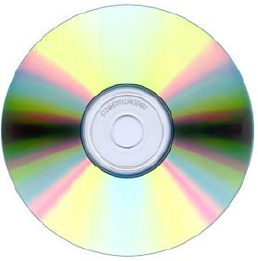
When putting a CD or DVD disk into its drive, push the eject button to open the drive or to eject the disk from the system. You will want to make sure to insert the disk in the tray or disk slot with the label facing up. For systems with disk trays, you then need to push the eject button on the drive to close the drive.
To listen to music on a CD, you usually just stick the CD into your CD drive, wait a few seconds, and the CD starts playing in your default music program, usually Windows Media Player. The same is true for most movie DVDs, but only if your computer has the appropriate hardware and software. The following is a quick rundown of where to look for more information on CDs and DVDs (besides this chapter):
- To listen to, copy from, or create your own music CDs: Chapter 24, “Making Music with Media Player”
- To watch DVD movies: Chapter 25, “Working with Video and Photos”
The most common mistake people make with CDs and DVDs is assuming they’re the same. After all, they look the same. But they’re not the same at all. Nor do you treat them like other kinds of disks. That’s why we’ve dedicated an entire chapter (Chapter 25) just to CDs and DVDs.
Portable devices
Technically, portable devices aren’t disks or disk drives. But some can store files. For example, digital cameras store pictures. Portable MP3 players store songs. When you connect such a device to your computer, Windows 8 provides access to the device as if it’s a disk drive. The contents of the device, such as photos or videos, show up in your Computer folder.
You can copy things to and from portable devices using many different techniques. For example, you can use Windows Photo Gallery (see Chapter 23) to get pictures from a digital camera. Windows Photo Gallery is included with the Live Essentials programs, both of which are available for free from Microsoft. Use Windows Media Player to copy songs to and from a portable MP3 player. You can also use more general techniques described in Chapter 28 to copy files to and from some portable devices.
Flash cards and memory sticks
Flash cards (also called memory cards and memory sticks) are a solid state medium, which just means there’s no spinning disk or drive head involved in getting information to and from the card. Memory cards come in many shapes and sizes. Figure 27.2 shows some examples.
FIGURE 27.2 Memory cards
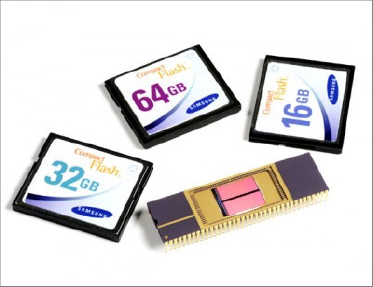
Most digital cameras and portable MP3 players use memory cards to store songs and pictures. When you connect the device to the computer, you get access to that memory card so you can copy files from it, or to it.
If your computer has memory card slots, you also have the option of putting the card right into a slot. Each slot into which you can insert a card shows up as an icon in your Computer folder. When you insert a card into a slot, you can copy files from it (or to it) using techniques described in Chapter 28.
Flash drives
A flash drive (or thumb drive) isn’t a disk at all. It’s more like a little gizmo you hang from a keychain, although you can also hide them in pens and pocket knives. Furthermore, you don’t need any special kind of drive for this storage medium because it is a drive. You just plug it into a USB port on your computer. Figure 27.3 shows examples of flash drives.
FIGURE 27.3 Flash drives
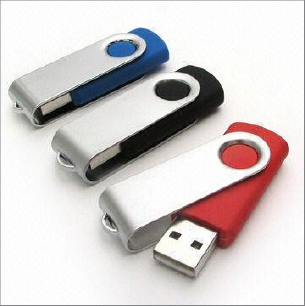
Once the flash drive is plugged in, it looks and acts just like a disk drive to Windows. You can move or copy files to it and from it using any technique described in Chapter 28. Flash drives come in all shapes and sizes. To see examples, go to any online retailer that sells computer accessories (www.newegg.com, www.cdw.com, www.amazon.com, or wherever) and search for thumb drive or flash drive.
Viewing your computer’s drives
Every disk drive in your computer is represented by an icon in your Computer folder. To open that folder, use whichever of the following techniques works for you:
- Click the Desktop icon on the Windows 8 interface and click the File Explorer button. On the left pane choose Computer.
- Click the File Explorer icon on the Windows 8 interface and click Computer on the left pane of File Explorer.
- Show the Charms Bar and choose Search. Type computer and choose the Computer option that displays.
- From the Windows desktop, click File Explorer and choose Computer from the left pane of File Explorer.
- Press Windows+X, click File Explorer, and choose Computer from the left pane of File Explorer.
Exactly what you see depends on what’s available in your PC. Figure 27.4 shows an example of a PC with lots of different drives.
FIGURE 27.4 Sample computer folder
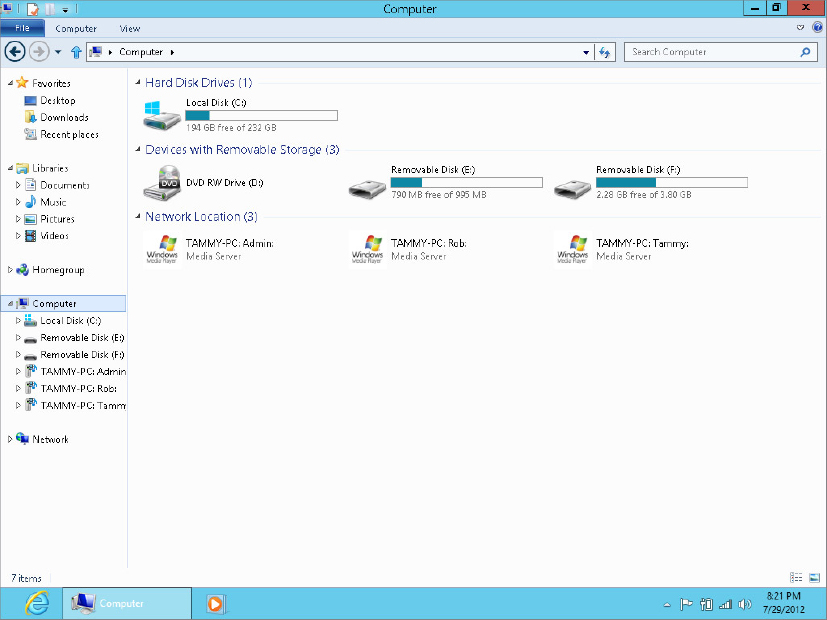
Don’t expect your Computer folder to look like the one in Figure 27.4. All computers are different and have different drives, slots, and portable devices that can connect. But you should see at least two categories of drives.
The first category is Hard Disk Drives. Your computer will have at least one of these named C. That’s the drive where everything in your computer is stored. One hard drive is sufficient for most users.
Under Devices With Removable Storage, you’ll see icons for other media. For computers that older than 5 years old, you may have a floppy disk drive (A:). You probably have a CD or DVD drive. Its letter could be D: or something else. In the figure, the DVD drive is D:. The computer in that picture also has a removable disk connected to it (E:).
Another category you might see, Portable Devices, shows icons only for devices that are currently connected to your computer. If you don’t have a camera or similar device connected when you open your Computer folder, you might not see a Portable Devices category. In the figure, a digital camera is connected to the computer and turned on, so it shows up under Portable Devices.
Finally, your Computer folder might also list other computers in your homegroup or local area network. This category is called Network Location. These devices are computers and shared drives that appear on networked computers.
You can leave your Computer folder open as you insert and remove disks. The names of icons that represent removable drives change to reflect the content of the disk that’s currently in the drive. When you remove the disk, the name reverts to the generic name for the drive. That’s a good thing to know if you’re new to all of this and don’t know what the icons in your own computer represent on your system.
Sizes and capacities
Every disk is like a container in which you store things. There’s a limit to how much data you can put on a disk. This is no different from any other container. For example, you can store water in a drinking glass, bucket, bathtub, or swimming pool. They’re all containers for water. They just vary greatly in their capacity (how much water each can hold).
If you liken different computer media to water containers, floppy disks, or Zip disks are like a drinking glass. A CD is like a bucket, a DVD like a bathtub, your hard disk like a swimming pool. Memory cards and flash drives vary in capacity, so it’s tough to liken any one to a water container. But they’re basically in the bucket-to-bathtub range.
With water, you measure things in ounces, liters, gallons, and such. In the computer world, the basic unit of measure is the byte. One byte equals roughly the amount of space required to store one character, like the letter a. For example, the word “cat” requires 3 bytes.
Most disks can hold thousands, millions, billions, even trillions of bytes. Most often the capacities are rounded to the nearest thousand, million, or billion bytes. That’s because disk storage is cheap and plentiful and there’s no point in fussing over a few thousand bytes here or there. Also, computer folks don’t even use the words “thousand,” “million,” or “billion.” They have shorter terms as follows:
- Kilo: Thousand
- Mega: Million
- Giga: Billion
- Tera: Trillion
That’s all you really need to know about those terms. For those who like their numbers more exact, Table 28-1 shows the facts in detail.
TABLE 28-1: Buzzwords for Disk Capacities and File Sizes

Let’s return to our analogy of water containers. Here are approximate capacities of common disk types:
- Floppy: 1.44 MB
- CD: 650–700 MB
- DVD: 4.7 GB
- Flash Drive: 4+ GB
- Hard disk: 230+ GB
Note that hard disks are available in many different capacities from about 230GB to 2TB or more. (Some computer systems still come with smaller hard drives, as little as 120GB.) Zip disks, memory cards, flash drives, and portable devices also vary greatly in capacity. The hard disk reigns supreme in its ability to store large amounts of information.
How much room is there?
Everything you store on a disk takes up some space. So once you start putting things on a disk, you have some used space and some free space. It’s easy to see how much space you have on a disk.
When you open your Computer folder, each hard disk has a little meter beside it (in Tile view) that shows how much space is used (blue) and how much free space is still available for storing data (white). For example, in Figure 27.4, Removable Disk E has 790MB of free space left. Its total capacity is 995MB (or about 1GB). Disk F, on the other hand, has 2.28GB free of a total of 3.80GB.
To see how much space is left on a flash drive, memory card, or other device, first insert the disk or card. Right-click the icon for that drive and choose Properties. You see a dialog box like the example shown in Figure 27.5. There you can see how much space is used, how much is still available, and the total capacity of the disk or card.
FIGURE 27.5 Used space, free space, and capacity
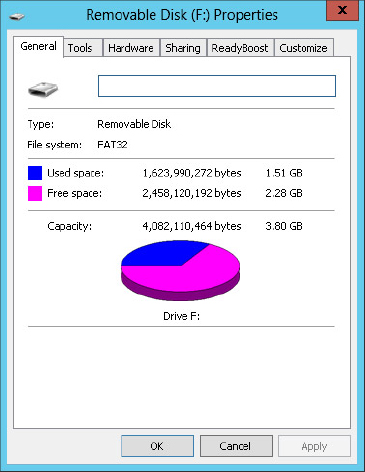
If you see 0 bytes capacity, that means you right-clicked the icon for a drive or slot that’s empty. An empty drive has no capacity because there’s no disk in it. The drive or slot doesn’t have a capacity. The disk or card in it has a capacity. No disk or card in a drive means no capacity (0 bytes).
If you check the capacity of a CD-ROM or DVD-ROM that’s already been burned, you might see 0 bytes free, even if the used space doesn’t match the total capacity of that drive. That’s because optical media (CDs and DVDs) don’t work quite like other types.
If you right-click the icon for a portable device, you might not see used space, free space, or capacity. Again, that’s just because the Properties sheet for a portable device tends to show information about the device as a whole, not just its storage. It’s no big deal, however, because typically you copy files from portable devices, not to them. Also you tend to use programs such as Photo Gallery and Windows Media Player to work with portable devices, not your Computer folder.
Viewing disk contents
Disks exist for one reason only — to store information. That information is stored in files, often organized into folders. To view the contents of a disk or memory card, insert it into its drive or slot and then open (double-click) its icon in your Computer folder. Make sure you insert the disk or card first because it makes no sense to open the icon for an empty drive.
For example, if there is no DVD in your DVD drive, it makes no sense to open that icon. There has to be a disk in the drive whose contents you want to view.
Like your hard disk, external disks store data in folders and files. Each folder and file on the disk is represented by an icon. Double-click a folder’s icon to view its contents. Double-click a file’s icon to open the file and see its contents. Use the Back button to back out of a folder to wherever you were before.
Formatting disks
Just about everyone has heard about formatting a disk. But not many people really understand what that’s about. So let’s start with some basic rules of thumb:
- Not all disks need to be formatted. Only blank, unformatted disks and a few other types need to be formatted. But only once, not each time you use the disk.
- Never presume that you have to format a disk. If a disk needs to be formatted, you’ll see a message telling you so and an option to format it right on the spot. If you don’t see such a message, don’t format the disk or even think about formatting the disk.
- Formatting a disk permanently erases the contents of that disk. Never format a disk unless you are 100 percent certain you will never need anything on that disk again for the rest of your life.
Don’t even think about formatting your computer’s primary hard disk. You won’t be able to anyway. But formatting your hard disk would erase Windows 8, all of your installed programs, contacts, saved e-mails, and saved files — everything. You don’t want to do that unless you really know what you’re doing and are certain that you can easily get back everything you lost in the process.
